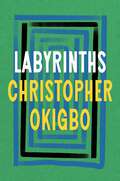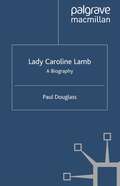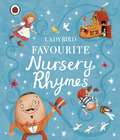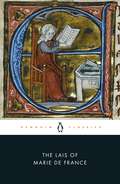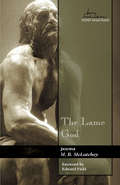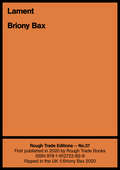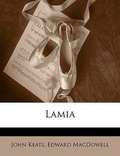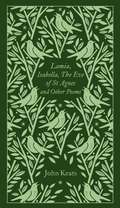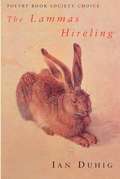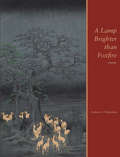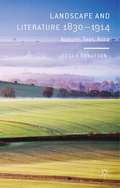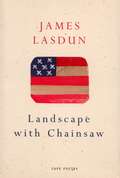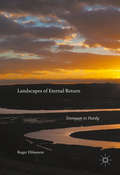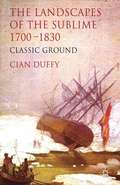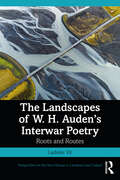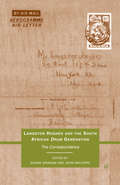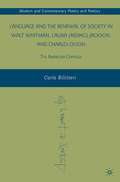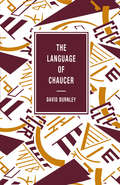- Table View
- List View
Labyrinths (Heinemann African Writers Ser.)
by Christopher OkigboLabyrinths is the celebrated collection of Christopher Okigbo's most renowned poems which cemented his reputation as one of Nigeria's greatest poets.In this powerful collection, Okigbo's renowned talent is showcased in vivid clarity as each poem draws the reader into an arresting world of myth and contemplation – a maze of spiritual homecomings, divine dreams, and the long-drums of the dead.Including Paths of Thunder, his final and most famous sequence of poems that prophesised a nation overcome by war. Written shortly before he was killed in the Nigerian-Biafran War, Okigbo predicted his own death and left behind a legacy as a leading figure of postcolonial poetry.'The finest Nigerian poet of his generation [and] one of the most remarkable anywhere in our time. Chinua Achebe'There are poets who have a magical presence in the literature of their lands... Christopher Okigbo is one such poet.' Ben Okri'One of the genuine renaissance people of our generation.' Wole Soyinka
Lady Caroline Lamb: A Biography
by P. DouglassLady Caroline Lamb , among Lord Byron's many lovers, stands out - vilified, portrayed as a self-destructive nymphomaniac - her true story has never been told. Now, Paul Douglass provides the first unbiased treatment of a woman whose passions and independence were incompatible with the age in which she lived. Taking into account a traumatic childhood, Douglass explores Lamb's so-called 'erotomania' and tendency towards drug abuse and madness - problems she and Byron had in common. In this portrait, she emerges as a person who sacrificed much for the welfare of a sick child, and became an artist in her own right. Douglass illuminates her novels and poetry, her literary friendships, and the lifelong support of her husband and her publisher, John Murray.
The Lady of the Lake
by Sir Walter Scott"The Lady of the Lake is a narrative poem by Sir Walter Scott, first published in 1810. Set in the Trossachs region of Scotland, it comprises six cantos, each of which concerns the action of a single day. The poem has three main plots: the contest among three men, Roderick Dhu, James Fitz-James, and Malcolm Graeme, to win the love of Ellen Douglas; the feud and reconciliation of King James V of Scotland and James Douglas; and a war between the lowland Scots (led by James V) and the highland clans (led by Roderick Dhu of Clan Alpine). The poem was tremendously influential in the nineteenth century, and did much to inspire the Highland Revival. By the late twentieth century, however, the poem was virtually forgotten. Its influence is thus indirect: Schubert's Ave Maria, Rossini's La donna del lago (1819), the racist custom of cross burning, the last name of U.S. abolitionist Frederick Douglass, and the song "Hail to the Chief" were all inspired by the poem.
Ladybird Favourite Nursery Rhymes
by Ladybird BooksThis beautiful hardback Ladybird treasury of favourite nursery rhymes is a beautifully illustrated introduction to many well-loved rhymes that are perfect for sharing with young children from 3+.With more than 100 rhymes including favourites such as Three Blind Mice, The Owl and the Pussy-cat, Humpty Dumpty and Head, Shoulders, Knees and Toes, there is a rhyme for everyone in this collection of animal, action, story, food, counting and bedtime rhymes.
The Lais of Marie De France: With Two Further Lais in the Original Old French (Penguin Classics)
by Marie France Keith BusbyMarie de France (fl. late twelfth century) is the earliest known French woman poet and her lais - stories in verse based on Breton tales of chivalry and romance - are among the finest of the genre. Recounting the trials and tribulations of lovers, the lais inhabit a powerfully realized world where very real human protagonists act out their lives against fairy-tale elements of magical beings, potions and beasts. De France takes a subtle and complex view of courtly love, whether telling the story of the knight who betrays his fairy mistress or describing the noblewoman who embroiders her sad tale on the shroud for a nightingale killed by a jealous and suspicious husband.
The Lame God (Swenson Poetry Award #16)
by M. B. McLatcheyWinner of 2013 May Swenson Poetry AwardIn The Lame God, author M. B. McLatchey reminds us of the inevitable bond between art and empathy. With a controlled language that finds its echo chamber in the immortal themes and characters of classical literature, this courageous work accompanies the author on her journey through a parent’s anguish in the face of a horrific crime. Using the art of poetry she gives voice to a suffering—and a love—that might otherwise go unheard. The May Swenson Poetry Award, an annual competition named for May Swenson, honors her as one of America's most provocative and vital writers. During her long career, Swenson was loved and praised by writers from virtually every school of American poetry. She left a legacy of fifty years of writing when she died in 1989. She is buried in Logan, Utah, her hometown.
Lament (Rough Trade Edition)
by Briony BaxBriony Bax leads the reader through the brutal world of mental illness and specifically an account of an individual’s journey with schizophrenia. A world where sections, court rooms, locked wards, tribunals, and assessment centres form the backdrop of the daily living of sufferers and caregivers. Through honesty and testimony, it shines a light on the disastrous effects of government austerity measures on the mentally ill.
Lamia
by John KeatsThough not one of John Keats' very best poems, Lamia is a major work and essential for anyone interested in him. It has his signature unparalleled beauty but is also unusually thoughtful, with intriguing musings on illusion vs. reality and the nature of love, beauty, and art. Keats' lament about empiricism destroying natural wonder has heavily influenced everyone from Edgar Allen Poe to Richard Dawkins, and Lamia remains central to the art/nature vs. science debate. The story is also interesting in itself; Keats brings a fantasy world vividly to life, draws us in emotionally, and even has a devastating ending. Finally, the poem is impressive technically, showing Keats' growing couplet mastery. One should certainly read his best-known works first, but this should be an early stop; that said, the fact that it is virtually every Keats collection makes a standalone very hard to justify. The important thing at any rate is to read it in some form.
Lamia, Isabella, The Eve of St Agnes and Other Poems (Penguin Clothbound Poetry)
by John KeatsIn the summer of 1820, Keats published this collection, his third and final volume of poetry. A few months earlier, he had started coughing up blood; the following February, he would die of tuberculosis in Rome, aged just twenty-five. This volume contains his greatest work, written in an astonishing burst of creative genius in 1819. It includes 'Lamia', his tale of love and betrayal in ancient Corinth; the haunting medieval romance of 'The Eve of St Agnes'; and his six famous odes, now considered among the most famous verse in the language.
The Lammas Hireling
by Ian DuhigIan Duhig has long inspired a fervent and devoted following. With The Lammas Hireling - the title poem having already won both the National Poetry Competition and the Forward Prize for Best Poem - Duhig has produced his most accessible and exciting volume to date, and looks set to reach a whole new audience. A poet of lightning wit and great erudition, Duhig is also a master balladeer and storyteller who shows that poetry is still the most powerful way in which our social history - our lives, loves and work - can be celebrated and commemorated.
A Lamp Brighter than Foxfire: Poems (Mountain West Poetry Series)
by Andrew S. Nicholson"In Andrew S. Nicholson’s A Lamp Brighter than Foxfire, what is most alive is color, that which gives itself freely, generously: ‘Follow the hopeful as they green the day’ (‘My Garage Fills with an Ever-Increasing Number of Dandelions’). Threaded throughout with Genesis, wherein Jacob wrestles an angel, this gorgeous debut collection builds a ladder firmly rooted here: in sun and earth; in varying and multiple shades of orange; in trials of father and son; in books and paintings; in abandoned casinos; in countries far from home; and/or in the sound of a door closing. Nicholson’s poems come from a man standing by himself, in what George Oppen called the ‘shipwreck of the singular,’ which includes everybody. I’m moved by the luminous generosity, the moral clarity of this work. A Lamp Brighter than Foxfire is news that will stay news.” —Claudia Keelan, author of The Devotion Field, Missing Her, and O, Heart "'Who doesn’t nurse a secret love?' asks Andrew S. Nicholson in visionary poems that reveal secret worlds cradled inside this one. Whether considering the casinos of Las Vegas, a fresco in Pompeii, or scenes from the Hebrew Bible, the poet endures one of desire’s more fraught paradoxes: its unchanging ability to bring change, to turn the known into the unknown. These poems bravely attend to such transformations the way Jacob—the book’s patron saint—wrestles with the angel, 'lifting all the flesh / that he can lose.' I admire this poet who knows that blessing doesn’t arrive without loss, who remembers 'I was loved once. / Beneath that love, a kindness took root.' The same sweet feeling lingers long after this book is closed. Dear reader: savor it." —Brian Teare "Andrew S. Nicholson’s A Lamp Brighter than Foxfire is a gorgeous book. His graceful, playful poems enchant us ('I try to make out the stranger’s face, but he’s shrinking: / a melting gray blur, an ever-smaller thorn.') and transform us ('Sink into the bathwater, any way is a way / to journey toward that joining'). Nicholson has become one of the great poets of a new and radical kind of pastoral." —Joseph Lease Opening the space between the ordinary and the visionary, the poems in A Lamp Brighter than Foxfire uncover an intimate relationship with the world, from Las Vegas to Italy to the American Midwest. From a lime glowing in an orchard to a miraculous childhood attempt at levitation, Andrew S. Nicholson’s poems ground themselves in the commonplace and leap for the luminous. Central to this collection are poems that retell stories of Jacob from the Old Testament, relocated behind casinos, glimpsed in miniature on kitchen floors, and heard speaking in a moment of decay. Through these retellings, Nicholson examines the creation of self, family relationships, and a generative sense of the divine.
Landscape and Literature 1830-1914: Nature, Text, Aura
by R. EbbatsonThis study examines the vital centrality of 'readings' of nature in a variety of literary forms in the period 1830-1914. It is exploratory and original in approach, stressing the philosophical and cultural implications in a range of texts from Tennyson, Hardy, Jefferies and Thomas.
Landscape With Chainsaw: Poems (Cape Poetry Ser.)
by James LasdunJames Lasdun's third book of poems explores the themes and tensions of his last two with a new boldness and exuberance, in a series of poems about life in the Catskill mountains outside Woodstock, where the author moved with his family some years ago. Questions of exile and belonging, cutting ties and forming new bonds, figure prominently, as does the struggle to find a viable relationship with the natural world of the mountain wilderness - at once a stunning companion and a ferocious competitor. Out of this - 'the need to carve out a niche for ourselves;/our singular relation to what we love' - rises the book's central image: the chainsaw. Very much a real machine (given to the alarmed poet by his wife), it also comes to form a complex symbol in which all manner of human traits are reflected with an intense, often comical, brilliance.A brilliantly assured, deftly lyrical sequence, Landscape with Chainsaw melds passion with wit, the classical with the quotidian, in a thrilling meditation on history, love, cultural identity and the anxiety of displacement. As an examination of the complexities of deracination and domesticity, it marks the matured genius of one of England's most important poets.
Landscapes of Eternal Return: Tennyson to Hardy
by Roger EbbatsonThis book is about the resonance and implications of the idea of ‘eternal recurrence’, as expounded notably by Nietzsche, in relation to a range of nineteenth-century literature. It opens up the issue of repetition and cyclical time as a key feature of both poetic and prose texts in the Victorian/Edwardian period. The emphasis is upon the resonance of landscape as a vehicle of meaning, and upon the philosophical and aesthetic implications of the doctrine of ‘recurrence’ for the authors whose work is examined here, ranging from Tennyson and Hallam to Swinburne and Hardy. The book offers radically new light on a range of central nineteenth-century texts.
The Landscapes of the Sublime 1700-1830: Classic Ground
by C. DuffyThe Landscapes of the Sublime examines the place of the 'natural sublime' in the cultural history of the eighteenth century and Romantic period. Drawing on a range of scholarship and historical sources, it offers a fresh perspective on the different species of the 'natural sublime' encountered by British and European travellers and explorers.
The Landscapes of W. H. Auden’s Interwar Poetry: Roots and Routes (Perspectives on the Non-Human in Literature and Culture)
by Ladislav VítThis is the first book-length study foregrounding Auden’s sense of place as a means for enhancing our grasp of this crucial twentieth-century poet. Proposing that Auden had a remarkable spatial sensibility, this book concentrates on his treatment of his homeland England, as well as the North Pennines and Iceland, both of which served as his ‘good’ places, ‘holy’ grounds and sources of topophilic sentiment. The readings draw on the scholarship of humanistic geography, tracing patterns of mental constructs which emerge from spatial experience. In a scholarly but engaging way, this book argues that focusing on Auden’s poetics of place as it emerged and evolved can be instrumental to our understanding of this influential poet not only in relation to his epoch but also to the Anglophone poetic tradition. Precisely because of his stature, these elaborations on Auden’s preoccupation with places, escapism, borders and local identity promise to enrich our understanding of the cultural and intellectual climate of the interwar period, when established notions of local places and cultures were beginning to be contested by internationalisation. This study will be of interest to both academics and students in the field of Anglophone literary studies while also appealing to those attracted to Auden’s poetry, interwar culture and the literary representation of space.
The Landscapes of W. H. Auden’s Interwar Poetry: Roots and Routes (Perspectives on the Non-Human in Literature and Culture)
by Ladislav VítThis is the first book-length study foregrounding Auden’s sense of place as a means for enhancing our grasp of this crucial twentieth-century poet. Proposing that Auden had a remarkable spatial sensibility, this book concentrates on his treatment of his homeland England, as well as the North Pennines and Iceland, both of which served as his ‘good’ places, ‘holy’ grounds and sources of topophilic sentiment. The readings draw on the scholarship of humanistic geography, tracing patterns of mental constructs which emerge from spatial experience. In a scholarly but engaging way, this book argues that focusing on Auden’s poetics of place as it emerged and evolved can be instrumental to our understanding of this influential poet not only in relation to his epoch but also to the Anglophone poetic tradition. Precisely because of his stature, these elaborations on Auden’s preoccupation with places, escapism, borders and local identity promise to enrich our understanding of the cultural and intellectual climate of the interwar period, when established notions of local places and cultures were beginning to be contested by internationalisation. This study will be of interest to both academics and students in the field of Anglophone literary studies while also appealing to those attracted to Auden’s poetry, interwar culture and the literary representation of space.
Langston Hughes and the South African Drum Generation: The Correspondence
by Shane Graham and John WaltersThis collection combines previously unpublished letters between African-American poet Langston Hughes and South-African writers of the 1950s and 1960s with scholarly commentary and criticism. The letters tell a fascinating story of the civil rights movement and apartheid and the struggle to overthrow it.
Language and the Renewal of Society in Walt Whitman, Laura: The American Cratylus (Modern and Contemporary Poetry and Poetics)
by C. BillitteriThis book takes up the utopian desire for a perfect language of words that give direct expression to the real, known in Western thought as Cratylism, and its impact on the social visions and poetic projects of three of the most intellectually ambitious of American writers: Walt Whitman, Laura (Riding) Jackson, and Charles Olson.
Language at the Boundaries: Philosophy, Literature, and the Poetics of Culture
by Peter CarravettaIs poetry still relevant today, or is it merely a dwindling historical art? How have poets of the recent past dealt with challenges to poetics?Seeking to chart the poetic act in a period not so much hostile as indifferent to poetry, Language at the Boundaries outlines spaces where poetry and poetics emerge in migration, translation, world literature, canon formation, and the history of science and technology.One can only come so close to fully possessing or explaining everything about the poetic act, and this book grapples with these limits by perusing, analyzing, deconstructing, and reconstructing creativity, implementing different approaches in doing so. Peter Carravetta consolidates historical epistemological positions that have accrued over the last several decades, some spurred by the modernism/postmodernism debate, and unpacks their differences--juxtaposing Vico with Heidegger and applying the approaches of translation studies, decolonization, indigeneity, committed literature, and critical race theory, among others. What emerges is a defense and theory of poetics in the contemporary world, engaging the topic in a dialectic mode and seeking grounds of agreement.
Language at the Boundaries: Philosophy, Literature, and the Poetics of Culture
by Peter CarravettaIs poetry still relevant today, or is it merely a dwindling historical art? How have poets of the recent past dealt with challenges to poetics?Seeking to chart the poetic act in a period not so much hostile as indifferent to poetry, Language at the Boundaries outlines spaces where poetry and poetics emerge in migration, translation, world literature, canon formation, and the history of science and technology.One can only come so close to fully possessing or explaining everything about the poetic act, and this book grapples with these limits by perusing, analyzing, deconstructing, and reconstructing creativity, implementing different approaches in doing so. Peter Carravetta consolidates historical epistemological positions that have accrued over the last several decades, some spurred by the modernism/postmodernism debate, and unpacks their differences--juxtaposing Vico with Heidegger and applying the approaches of translation studies, decolonization, indigeneity, committed literature, and critical race theory, among others. What emerges is a defense and theory of poetics in the contemporary world, engaging the topic in a dialectic mode and seeking grounds of agreement.
The Language of Chaucer (The Language of Literature)
by David BurnleyIn this book David Burnley demonstrates that an understanding of Chaucer's social, cultural, and literary world is vital to our understanding of his language and meaning. The first part of the book, drawing on modern linguistics, concentrates on the text and on approaches to interpreting the poet's grammar and syntax. The second part treats Chaucer's language and vocabulary in its broader contemporary context, dealing with language use, style and variety.
The Language of Contemporary Poetry: A Framework for Poetic Analysis (Palgrave Studies in Language, Literature and Style)
by Lesley JeffriesThis book introduces a new way of looking at how poems mean, drawing on the framework first developed in the author’s book Critical Stylistics, but applied here to aesthetic more than ideological meaning. The aim is to empower readers of poetry to articulate the features of poetic language that they come across and explain to themselves and others why these features convey the meanings that they do. While this volume focuses on contemporary poets writing in English and mostly based in the UK and Ireland, the framework will work just as well for other eras’ poetry, as well as for other cultures and languages.
The Language of Dystopia (Palgrave Studies in Language, Literature and Style)
by Jessica NorledgeThis book presents an extended account of the language of dystopia, exploring the creativity and style of dystopian narratives and mapping the development of the genre from its early origins through to contemporary practice. Drawing upon stylistic, cognitive-poetic and narratological approaches, the work proposes a stylistic profile of dystopia, arguing for a reader-led discussion of genre that takes into account reader subjectivity and personal conceptualisations of prototypicality. In examining and identifying those aspects of language that characterise dystopian narratives and the experience of reading dystopian fictions, the work discusses in particular the manipulation and construction of dystopian languages, the conceptualisation of dystopian worlds, the reading of dystopian minds, the projection of dystopian ethics, the unreliability of dystopian refraction, and the evolution and hybridity of the dystopian genre.
The Language of French Symbolism
by James R. LawlerThe traits that characterize the "language" of French Symbolism are the center of these essays. In interpreting major or previously neglected compositions by Mallarmé, Verlaine, Rimbaud, Claudel, Valéry, and Apollinaire, the author shows how each of these poets worked with the elements that distinguish this influential group of writers as a whole.Originally published in 1969.The Princeton Legacy Library uses the latest print-on-demand technology to again make available previously out-of-print books from the distinguished backlist of Princeton University Press. These editions preserve the original texts of these important books while presenting them in durable paperback and hardcover editions. The goal of the Princeton Legacy Library is to vastly increase access to the rich scholarly heritage found in the thousands of books published by Princeton University Press since its founding in 1905.
